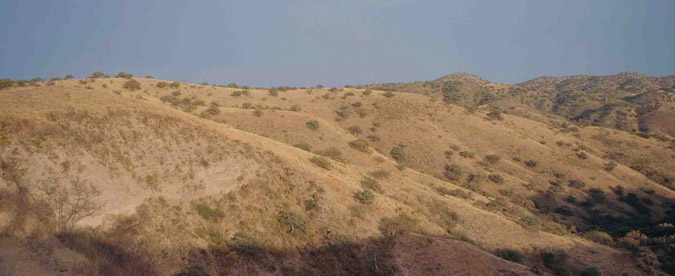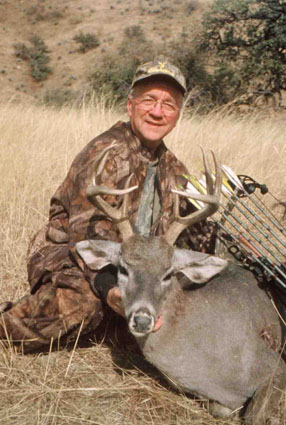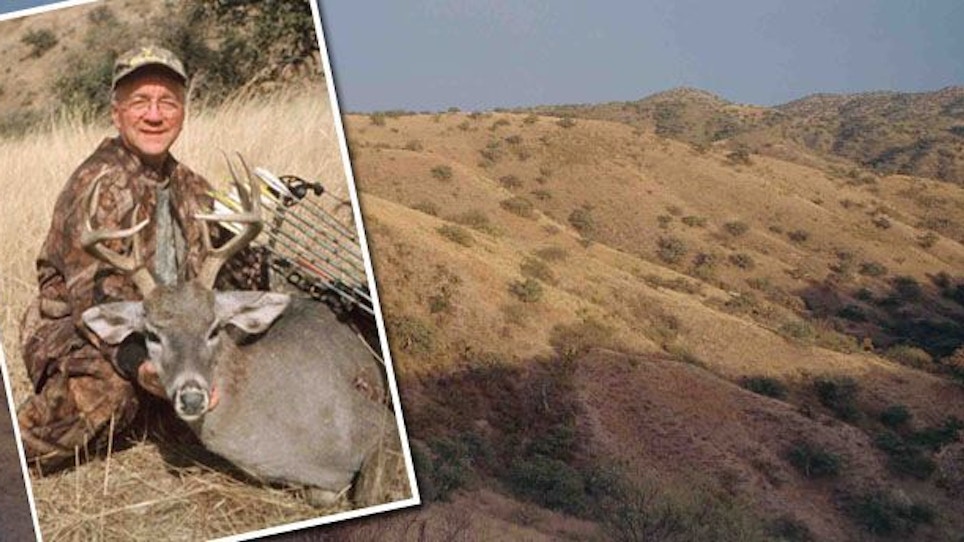It was a typical early morning as I climbed into my tree stand. Cold, clear, with little wind. My anticipation was higher than a kite. After getting strapped in, I leaned against the tree, eyes closed, relaxed and excited. I listened to a calling owl in a nearby ravine and waited for first light. As the sun slowly peeked over the ridge, a doe walked nervously beneath my stand. Just another typical deer hunt?
Nope. I was hunting in some of the driest country in North America — the Sonora region of old Mexico. The stand was in a scrubby Encino oak, so small that I was barely eight feet off the ground. But the whitetails were there, and by noon, more than thirty had come to the nearby water. As dry as this arid country normally was, on this early January day it was even drier due to an extended drought. The small pond near my stand was the only water source for at least a mile, and it was a magnet to the Coues deer that thrived in this arid country.
After a long run of does, a dandy Coues buck snuck to the pond, and my arrow flew true. After climbing the nearby hill to get phone reception, I called the guide to come and get me. Excitement was high as we drove off the mountain. In the back of the truck was one of my most prized trophies and one of the most challenging animals a hunter could ever harvest — a great Coues buck.
Where To Hunt Coues Deer

More than 80 percent of all hunters live east of the Mississippi River. I’m among them, and our perception of whitetail habitats are upland or bottomland hardwoods, agricultural crops and river bottoms. That’s the basic image we have of whitetail habitat, but as you head southwest, the country gets very dry. Nevertheless, the whitetails are there, in arid country with mesquite, scrub oaks and cacti — living on the extreme.
I guess we shouldn’t be surprised to find deer in the Southern extremes of North America, because they are the most genetically variable grazing mammals in the world. As proof of this variability, there are 30 subspecies of our whitetail (Odocoileus virginianus) found from Nova Scotia to Florida, northern Alberta to Peru. Yes, a bunch of subspecies of whitetails live south of the Mexican border all the way through Central America and into South America.
Subspecies are usually determined by genetic makeup. But we have little genetic knowledge of the 16 whitetail subspecies that live in the dry Southwest and into Central America. Thus, physical variation in characteristics such as hair color determines the subspecies for deer living in one region. While it’s true that many of these arid-region subspecies are scattered and limited by habitat and over-hunting at the local level, the deer are there, living in the thorny scrub bush of the Sonoran Desert foothills to the tropical rainforests of Panama and beyond.
 Little is known about most of the subspecies of whitetails found in Central and South America, and we probably will never know much about most of them. But two of these whitetail subspecies have been singled out and are listed in the record books. The Coues deer (Odocoileus virginianus couesi) is listed in the record books kept by the Boone and Crockett Club (B&C), Pope and Young Club (P&Y) and by Safari Club International (SCI). The Coues is one of the smallest of the huntable whitetails and is judged by many to be the toughest nut to crack among all the North American big-game species. They live in mountainous terrain in very arid country filled with shrubs and scrub trees and other thorny vegetation. It’s inhospitable country, but the Coues deer thrives in these extremes.
Little is known about most of the subspecies of whitetails found in Central and South America, and we probably will never know much about most of them. But two of these whitetail subspecies have been singled out and are listed in the record books. The Coues deer (Odocoileus virginianus couesi) is listed in the record books kept by the Boone and Crockett Club (B&C), Pope and Young Club (P&Y) and by Safari Club International (SCI). The Coues is one of the smallest of the huntable whitetails and is judged by many to be the toughest nut to crack among all the North American big-game species. They live in mountainous terrain in very arid country filled with shrubs and scrub trees and other thorny vegetation. It’s inhospitable country, but the Coues deer thrives in these extremes.
Record-Book Coues Bucks
There are about 100 typical Coues bucks listed in the latest P&Y record book, and only five non-typicals. The world-record Coues, taken in 1953 in Arizona with a rifle, scored 144 1/8. To give you an idea of the smaller body and antler size of the Coues, consider that only 12 gun-killed Coues bucks in the B&C record book scored above 125 inches. Only around 250 bucks are listed in the B&C record book.
SCI recognizes several whitetail subspecies, including the Coues deer, and it’s the only record book to include the Carmen Mountain subspecies of whitetail. Carmen Mountain whitetails live in mountainous habitats in southwest Texas in and around Big Bend National Park. They are found at higher altitudes, usually somewhere near 6,000 feet, and this separates them from other Texas deer. In addition, this deer only stands an average of 31 inches at the shoulder, making it about 10 inches shorter than an average Texas whitetail and just a tad smaller than the Coues.
Scattered throughout Mexico are other subspecies, such as the Acapulco whitetail, the lowland Mexican whitetail, the Oaxaca whitetail, the rainforest whitetail, the Veracruz whitetail and others. All are a reflection of the diversity of habitats where you can find this great animal. So, the next time you see a whitetail in our hardwoods or farm country, remember that there are a variety of other whitetails living in habitat that runs from desert to rainforests. You’ll find them in southern Arizona, New Mexico and Texas and everywhere south of the border, down Mexico way.






